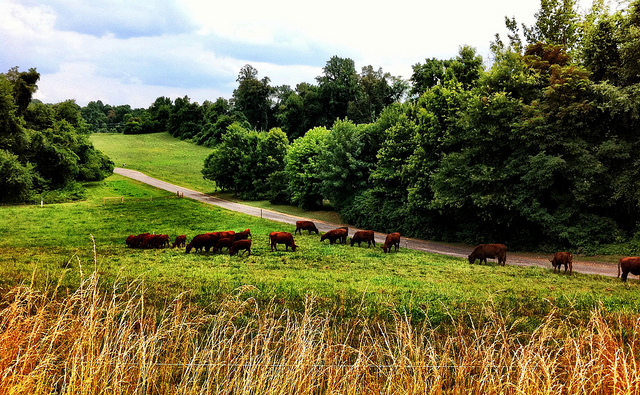Grass Fed Beef From Australia Open Nature
You are here: Home / Food / Food Industry / "Grass-Fed" On The Label: What It Does (And Doesn't) Tell You
I spied a new product in my grocery store the other day — vacuum-packed beef sold under Safeway's Open Nature brand.
The label indicated this beef came from grass-fed, hormone-free, antibiotic-free cows. Woo-hoo! It was more expensive than the stuff packed in the butcher case — but not by much. And since we've been buying grass-fed beef from a local rancher, this new supermarket offering piqued my curiosity.

But I took a step back…What does the "grass-fed" label really mean?My research into food labeling regulations has opened my eyes, and the more I've learned, the more I've come to suspect that many (most?) labels are just full of crap (and frankly downright insulting at times). So I mentally added a "Research Grass-Fed Meat Labels" task to my to-do list and did some analysis for all of us.
How the USDA Defines "Grass-Fed"
The USDA's 2007 voluntary standard, "United States Standards for Livestock and Meat Marketing Claims, Grass (Forage) Fed Claim for Ruminant Livestock and the Meat Products Derived From Such Livestock", governs grass-fed claims using the following criteria:
- Animals must eat only grass and forage throughout their lives, except when consuming milk before weaning. They can't eat or be fed grain or grain byproducts, but food from cereal crops in the vegetative (pre-grain) state is ok.
- They must have "continuous access to pasture during the growing season." The growing season is defined as the time between average last frost and average first frost in the animal's locale. During winter months or drought conditions, they must continue to eat only grass and forage — no grain.
- Animals may be given routine mineral and vitamin supplements. Producers have to document anything not considered routine.
How the USDA's Grass-Fed Standard Works
Under the standard, producers must obtain a USDA evaluation prior to using the grass-fed label or marketing a product as grass-fed. Evaluation procedures are documented in the USDA's Quality Systems Verification Programs (QSVP), a pre-existing set of programs designed to "provide independent verification that special processes and/or marketing claims are clearly defined and verified by an independent third party."
What the Standard Doesn't Tell You
The "access to pasture during the growing season" requirement means that animals could be confined to pens or feedlots during much of the year. Additionally, producers who had been previously certified under the USDA's QSVP requirements were grandfathered in on the grass-fed label. Any farmer using the term "grass-fed" before the 2007 standard was created can continue to use it, whether he now complies with the standard or not.
My Takeaways
The grass-fed label appeals to me because I want my food to come from animals that were raised under natural conditions, particularly now that I know the horrific truths about how much of our meat is produced. And I want to support ranchers and companies that feel the same way I do. But I won't blindly believe that "grass-fed" implies all that.
I did some research on Safeway's Open Nature grass-fed beef and have no reason to suspect its meats aren't produced in line with my interests. Its website states its animals are humanely and sustainably raised, vegetarian-fed, and free of antibiotics, hormones, and preservatives. This is refreshing and inspiring to see from a major supermarket chain. Will I buy it? Maybe, maybe not. I love supporting my local grass-fed beef producer, but he's not always down the street waiting for me to drop by and pick up a Friday night steak. I like having options. I will most likely give this meat a try.
Here's what's really cool to me: If I do buy this product, it will be with open eyes. It's powerful to be able to hit the web, do a bit of research, and find a wealth of reliable sources that empower us through information. Way to go, researchers, scientists, consumer advocates, educational groups, writers, and food lovers.
Are You Obsessed With Food Labels Like I am?
Here are a few posts you should check out:
- Don't Be Leanwashed: Five Food-Words That Should Be Banned
- What Do Those Egg Carton Labels Really Tell You? (Infographic)
- Blog Action Day: What Do Meat Labels Really Mean?
- Food Labels for Ecovores: Avoiding Hidden Animal Ingredients
- Food Label Fact and Fiction
Would you buy Open Nature's grass-fed beef based on what I've learned? Share your thoughts.
Image Credit: krossbow via flickr/CC
Join The Free Insteading Community
We're building a place for homesteaders to connect, share what works, and grow their skills. In the Insteading community you'll find:
- 🖥 Ad-free versions of some of our best blog content
- ⏯ Ad-free versions of our Youtube videos
- 🐓 Our complete 3-hour video course, The Beginner's Guide to Raising Chickens
- 🙋♀️ Weekly polls & questions to engage with other members of the community
- 🌟 Q & A's with other homesteaders, gardeners, & industry experts
- 🌳 Lots of specific topics and groups to join
- 🪴 A fun place to engage with others who have the same interests as you
Ready to get started?
👉 Sign Up For Free
Reader Interactions
hansonverlable1941.blogspot.com
Source: https://insteading.com/blog/grass-fed-label/
0 Response to "Grass Fed Beef From Australia Open Nature"
Post a Comment